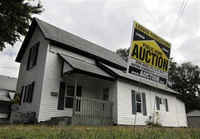USA, New wave of foreclosures threatens market
While banks repossessed fewer homes in February than a month earlier, borrowers continued to fall behind on their payments, adding to the inventory of properties headed toward foreclosure that have yet to be put on the market, according to RealtyTrac.
WASHINGTON - The housing market is facing swelling ranks of homeowners who are seriously delinquent but have yet to lose their homes, and this is threatening a new wave of foreclosures that could hit just as the real estate market has begun to stabilize.
About 5 million to 7 million properties are potentially eligible for foreclosure but have not yet been repossessed and put up for sale. Some economists project it could take nearly three years before all these homes have been put on the market and purchased by new owners.
And the number of pending foreclosures could grow much bigger over the coming year as more distressed borrowers become delinquent and then, if they can't obtain mortgage relief, wade through the foreclosure process, which often takes more than a year to complete. As these foreclosed properties add to the supply of homes for sale, they could undercut housing prices, which have increased modestly through December, according to the most recent figures in the S&P/Case-Shiller home prices index. That rise partly reflected a slowdown in the flow of foreclosed homes onto the market. The rate at which J.P. Morgan Chase seized properties, for example, peaked in the middle of 2008 and fell steadily last year, according to a February investor report. But the bank expects repossessions to increase this year, nearly doubling to 45,000 by the fourth quarter.
Backlog
"Some of the positive housing data may not be signaling a true turning point, as many servicers are holding back on foreclosures and the related houses are not yet being offered for sale," said Diane Westerback, a managing director at Standard & Poor's. Westerback said it could take 33 months to clear the backlog.
Data released Thursday by RealtyTrac illustrate the dynamic . While banks repossessed fewer homes in February than a month earlier, borrowers continued to fall behind on their payments, adding to the inventory of properties headed toward foreclosure that have yet to be put on the market, said Daren Blomquist, RealtyTrac's spokesman.
"Just looking at the numbers, we would expect there to be a bigger percentage of properties" repossessed by banks by now, he said.
This "shadow market" reflects the increasing lag between defaults and foreclosures. Many lenders are struggling to keep up with the overwhelming number of borrowers who can't make their payments, and they're reluctant to rush repossessed homes onto the market when prices are depressed.
Today's delinquent borrowers, for the most part, differ in a key regard from those who were caught up in the surge of defaults in 2008. That earlier wave, which precipitated the financial crisis, consisted largely of subprime borrowers who defaulted when their risky loans became unaffordable.
Click for related content
Mortgage rates fall below 5 percent mark
Homebuyer credit not jolting housing market
NYT: Plan to pay homeowners to sell at loss
The borrowers in trouble now are, for the most part, people who have better credit and safer loans and have become delinquent because they've lost their jobs or are dealing with other economic setbacks, economists said. More than 75 percent of the borrowers who are now seriously delinquent — meaning they have missed at least three monthly payments — have traditional prime loans, according to First American CoreLogic. Most of these borrowers have not made a mortgage payment in six months.
These borrowers are among the most difficult to help. Homeowners with economic troubles such as extended unemployment often cannot make even reduced mortgage payments. And the longer borrowers stay delinquent, the more difficult it is to fashion a mortgage relief plan for them.
Some lenders are giving distressed borrowers more time to see whether they can modify the terms of their loans.
It can take a borrower six to seven months to find out whether he or she qualifies for a permanent loan modification under the federal foreclosure relief program, Making Home Affordable, according to Barclays Capital.
In Maryland, for example, lawmakers extended the foreclosure process from 15 days to 135 days in 2008 and are considering emergency legislation to force lenders into mediation with a borrower before foreclosing on a property. But other states and jurisdictions have even more drastic measures to slow down the foreclosure process. "There were cases where sheriffs were refusing to file foreclosure notices," said Jay Brinkmann, chief economist for the Mortgage Bankers Association.
After a temporary foreclosure moratorium in 2008, the backlog of homeowners facing foreclosure in Maryland has surged. The number of Maryland homeowners who are seriously delinquent or in the midst of the foreclosure process nearly doubled during the fourth quarter of 2009 compared with the same period a year earlier, according to data from the Mortgage Bankers Association.
"Lenders are deluged by late-stage delinquencies. The pent-up foreclosure inventory is there," said Massoud Ahmadi, director of research for the Maryland Department of Housing and Community Development.
The uptick in foreclosure sales is helping depress Maryland home prices, he said. "We have seen that home sales are on an upswing, but prices are on a downswing. That is the impact of the shadow inventory. It is keeping prices down," Ahmadi said.
In addition to those already in default are 11 million more U.S. borrowers who owe more on their mortgage than their home is worth — known as being underwater — and are in danger of becoming delinquent, said Sam Khater, chief economist for First American CoreLogic .
Over the past year, the number of foreclosed homes going up for sale has declined. Distressed properties made up just 38 percent of purchases in January, compared with the 49 percent peak in March 2009, according to the National Association of Realtors. That helped the inventory of homes on the market fall to a 7.8-month supply, close to the figure during normal times and down from more than 11 months in July 2008. But as prices continue to stabilize, lenders are likely to take advantage of the situation by putting more of these distressed properties on the market, economists said. Story continues below.
"Banks have remained in foreclosure paralysis, allowing that backlog to get larger and larger. You can't do that indefinitely," said Sandeep Bordia, head of U.S. residential credit strategy at Barclays Capital. That impact could be muted if enough buyers emerge to snap up properties or efforts to enroll borrowers in mortgage relief programs improve. Some lenders are looking for ways to ease delinquent borrowers out of their homes without a foreclosure. For example, lenders are allowing more short sales, in which the home is sold for less than the outstanding loan balance. Citigroup is testing a program that allows delinquent borrowers to stay in their home for six months free if they leave the property in good condition, making it easier to sell afterward.
"We are anticipating a foreclosure glut that is likely to come up in next 16 to 18 months. We are trying to stay ahead of this," said Sanjiv Das, chief executive of CitiMortgage. These types of programs are "protecting house prices and consumer sentiment from going down further," he said.
The impact of the coming foreclosure wave will vary by region. The Washington area has a "shadow inventory" of about 67,000 properties that could go into foreclosure this year, an 11-month supply at the current sales rates, according to research by John Burns Real Estate Consulting in Irvine, Calif. That is slightly higher than the national average but far less than the hardest-hit communities, such as Orlando and Miami, where there is two-year backlog.
And the backlog will hang over some communities for years. By the end of 2012, 39 percent to 50 percent of home purchases in Phoenix will still be foreclosed properties, J.P. Morgan Chase has estimated. In Los Angeles, they'll account for 28 percent of home sales.

